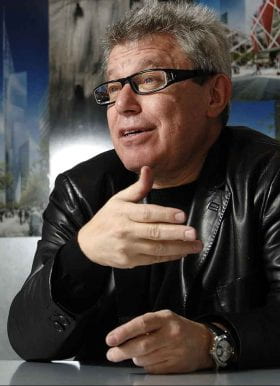
Daniel Libeskind
Daniel Libeskind, one of the most celebrated architects working today, will discuss “The Future of Cities” as part of the Assembly Series at Washington University in St. Louis. His presentation, sponsored by the Sam Fox School of Design & Visual Arts and the Architecture Student Council, will begin at 6:30 p.m. Tuesday, April 2, in Graham Chapel.
Daniel Libeskind, one of the most celebrated architects working today, will discuss “The Future of Cities” as part of the Assembly Series at Washington University in St. Louis.
His presentation, sponsored by the Sam Fox School of Design & Visual Arts and the Architecture Student Council, will begin at 6:30 p.m. Tuesday, April 2, in Graham Chapel. The event is free and open to the public, though seating for the public may be limited. A Q&A will immediately follow.
Born to Holocaust survivors in Łódź, Poland, in 1946, Libeskind was a virtuoso musician at a young age, but gave up music to focus on architecture. He became an American citizen in 1965, earning his undergraduate degree in architecture from Cooper Union in 1970 and a postgraduate degree in the history and theory of architecture from the School of Comparative Studies at Essex University in 1972.
Libeskind established his architectural studio in Berlin in 1989, after winning the competition to build the Jewish Museum. Even before its opening, in 2001, the museum’s radical, strikingly asymmetrical design — filled with disorienting angles, underground passages and slit windows — became an icon for the City of Berlin and Germany. (Some commentators went so far as to suggest that the museum remain empty, a monument to the void left by the Holocaust. However, Libeskind and museum director Michael Blumenthal noted such proposals defeat the project’s purpose, which is to pay homage to the rich cultural contributions of Germany’s Jewish community.)
Studio Daniel Libeskind moved its headquarters from Berlin to New York City in February 2003, when Libeskind was selected to lead the Ground Zero Master Plan.
Serving as both the conceptual basis and the technical foundation for the entire redeveloped complex, the plan encompasses four new towers, a transportation hub, a visitors pavilion, a memorial and a memorial museum.The plan dictates the location and massing of each program element, including building height and relative size as well as proximity and the relationships between them. As Libeskind has noted, the project represents both a “healing of New York” and “a space to witness the resilience of America.”

Today, in addition to the New York headquarters, Studio Libeskind has European partner offices based in Zürich and Milan. Its practice spans museums and concert halls as well as convention centers, university buildings, hotels, shopping centers and residential towers. Projects range from the Military History Museum in Dresden and the Creative Media Center in Hong Kong to major extensions of the Denver Art Museum and the Royal Ontario Museum in Toronto.
In addition to his design work, Libeskind is regarded as one of architecture’s preeminent theorists. His books include Breaking Ground: Adventures in Life and Architecture (2004); Daniel Libeskind: The Space of Encounter (2001); Libeskind Speaks: Writings of Construction (1999); and Radix-Matix: Architecture and Writings (1997).
Libeskind has taught and lectured at many universities worldwide. He has held such positions as the Frank O. Gehry Chair at the University of Toronto; Professor at the Hochschule für Gestaltung, Karlsruhe, Germany; the Cret Chair at the University of Pennsylvania; and the Louis Kahn Chair at Yale University.
He has received numerous awards including the 2001 Hiroshima Art Prize — an award given to an artist whose work promotes international understanding and peace, never before given to an architect.